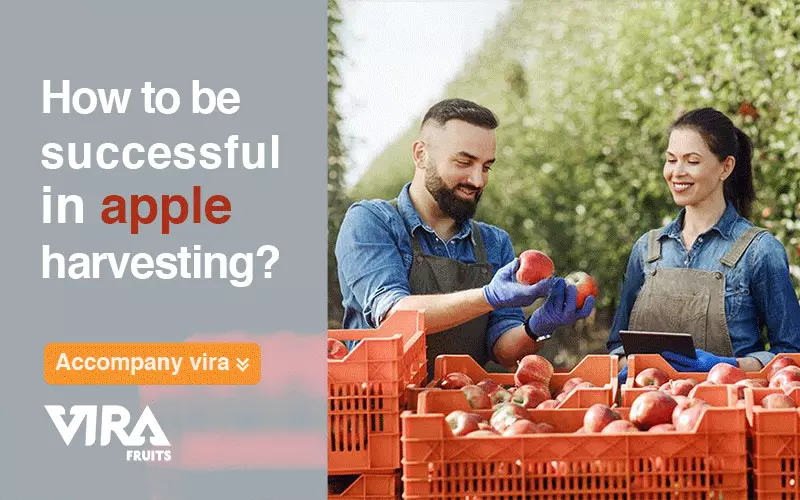Apples are a challenging crop to grow profitably in today’s market. In order to achieve success, growers must continually improve their management skills. And since many Iranian apple exporters like Vira Fruits deal with growers, apple harvesting should be their concern too. One of the most important steps, which is very difficult and challenging for growers, is harvesting.
Unfortunately, poor harvesting and handling procedures can negate all the hard work and expertise put into growing quality fruit. Growing fruits successfully and handling them correctly could mean the difference between financial success and failure for a grower.
Ripeness and maturity
Despite their sweetness, ripe apples won’t hold up to long-term storage. Apples that are ripe have a more intense flavor than apples that are simply mature and can be eaten fresh, as well as used for baking, preserving, and cooking. Although mature apples can be eaten and used fresh but on the other hand, they are one step far from ripeness. The tartness and starchiness of these apples will be higher than fully ripe fruit.
Apples are a kind of fruit that will continue ripping after being picked. The apple you are picking should be at least mature, if not ripe, depending on what you intend to do with it.
Professionals and successful growers start testing their apples two weeks before they are expected to harvest. They test their firmness, color, and starch content.
Apples get mature at various rates in only one tree, let alone different trees. Getting mature will start from the southern side of the tree. So that is the part you should start testing.

When to pick
It is highly important to harvest your apples at the right time in order to get the best fruit quality and to maximize storage life. For each kind of apple, maturation time varies, and that is important because due to this matter, harvesting time changes. This matter depends on weather conditions during the growing season. For instance, when the spring is mild, sunny, and the tree starts fruiting early, apples will ripen sooner.
Due to this matter, there are many important indicators to take into account rather than just a date on the calendar. Mature apples should be firm, crisp, and juicy with nice color and a flavor that suits the variety. However, red varieties cannot be distinguished by color alone as maturity. You can witness red delicious apple getting red before it is ripened. In addition to the skin color, seed color is not an enough reliable indicator. Although the color of the seeds in most varieties becomes brown when it reaches harvesting time, but there are some types in which the seed becomes brown weeks before the harvesting time.
Harvesting at the right time is the success key. Because if you harvest prior to the right time, apples will taste sour and starchy. Also, if harvested too late, they become soft and mushy.

What are the methods in apple harvesting
In cases in which the quantity of the harvested fruit is more critical than the quality, machinery harvest may be the most suitable option for apples to be processed. In contrast, manual harvest is preferred for fresh apples. To avoid bruising, it is best to pick them by using the rolling method. In this method, apples are turned upside down on the spur.
How to store apples
After harvesting apples, they must be stored and, in the next step, reach the customers. Preserving fruit quality and reducing waste at this stage is crucial. Apples can survive up to 12 months under optimal storage conditions between -1 and 4oC and humidity levels of 90-95%.
Farmers must manage harvest efficiently so as to maintain fruit quality and yields. Proper apple harvesting depends on farmers’ observation and activities at the right time. A farmer’s financial success depends on his ability to track harvesting.
Conclusion
Harvesting apples is an important stage that needs attention and care. Various kinds differ when harvesting. Farmers should pay close attention to the skin color and seed color, and other signs in order to harvest at the right time and prevent any damages. This a one of the important success keys for farmers.
